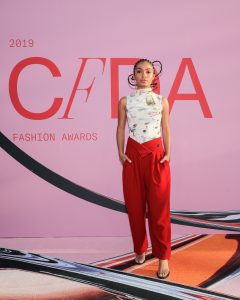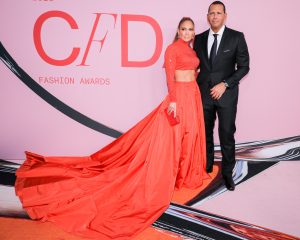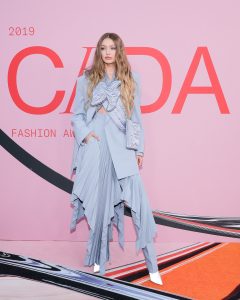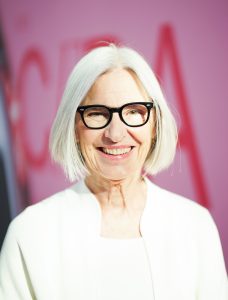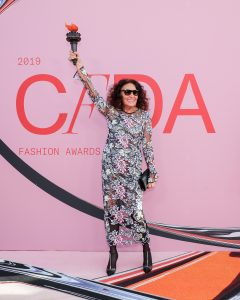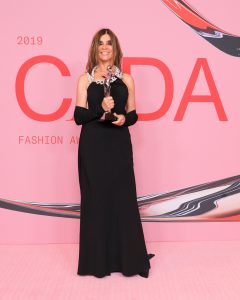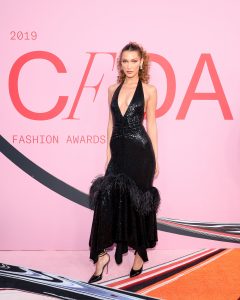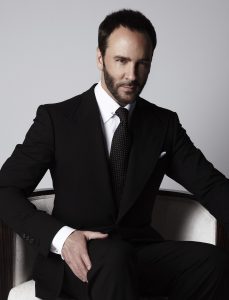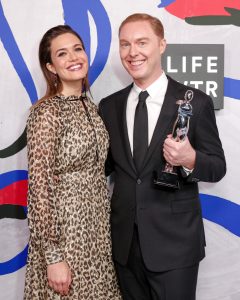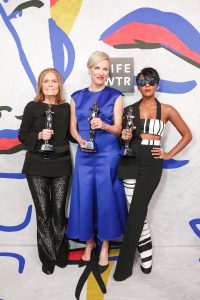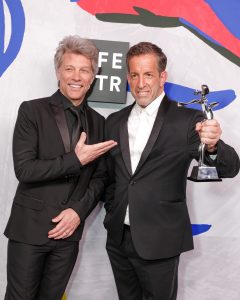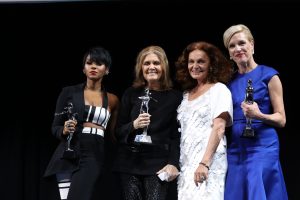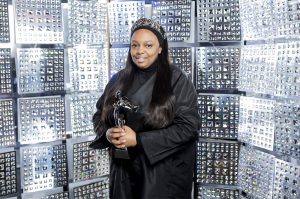November 12, 2020
by Carla Hay

Directed by Christian D. Bruun
Culture Representation: Taking place in New York City, the documentary “Calendar Girl” features a group of predominantly middle-aged and senior citizen white people (with a few Asians and African Americans) discussing Fashion Calendar founder Ruth Finley, who also participated into the documentary.
Culture Clash: Finley was very resistant to new technology and refused for years to sell Fashion Calendar.
Culture Audience: “Calendar Girl” will appeal primarily to people who are interested in the American fashion industry and New York Fashion Week.

Long before software spreadsheets and the Internet existed, the schedules of the U.S. fashion industry in New York City were and still are largely influenced by the subscription publication Fashion Calendar, which launched in 1941. Ruth Finley was the founder of Fashion Calendar, which is still considered the most influential scheduling “bible” for people in American fashion, especially those who attend New York Fashion Week. Finley’s name might not be as famous as longtime Vogue (U.S.) editor-in-chief Anna Wintour, but Finley holds a place in fashion media as an underrated pioneer. The engaging documentary “Calendar Girl” tells Finley’s story.
Directed by Christian D. Bruun, “Calendar Girl” (which had its world premiere at DOC NYC in 2020) was filmed over the course of several years in the 2010s. Finley passed away in 2018, at the age of 98, but she fully participated in the film, which includes interviews with numerous colleagues and family members of Finley. A few of the interviewees have also since passed away, such as photographer Bill Cunningham and former Bloomingdale’s executive Joseph “Joe” Siegel, who was Finley’s beau toward their end of their lives. Therefore, “Calendar Girl” looks dated in some ways, but the inspiring message of the movie is timeless.
Rather than giving a boring and predictable chronological telling of Finley’s story, “Calendar Girl” gives a non-chronological but insightful overview of Finley as a businessperson, mother and beloved influencer, as well as how she fits into the larger cultural context of the fashion industry. The movie begins with footage of her being honored at a 2014 Hall of Fame Tribute to celebrate Fashion Calendar, an event presented by Citymeals on Wheels. Later in the documentary, there’s footage of Finley getting the Board of Directors’ Tribute at the 2014 Council of Fashion Designers of America (CFDA) Awards, as well as Finley receiving the Fashion Institute of Technology (FIT) President’s Lifetime Achievement Award in 2016.
Through Finley’s own words and the words of her colleagues and her three sons (Joe Green, Jim Green and Larry Lein), a story emerges of a dedicated and sassy woman who went against society norms to start Fashion Calendar during an era when women were expected to not have careers. She was a single, working mother for most of her career, long before it was common or even acceptable to be a mother who worked outside of the home. Finley also kept working well past the age when most people are expected to retire.
And her passion for fashion is almost unparalleled, as she kept up her rigorous work schedule for decades. She was tirelessly attending fashion shows well into her 90s. “Calendar Girl” includes footage of her attending some of these shows. In the documentary, Finley says, “Sometimes I do as many as 12 shows a day.” She also mentions that her personal career record for going to fashion shows was attending 150 shows in one week.
Fashion Calendar had a very simple concept that worked extremely well: Publish a calendar schedule of all the major fashion events happening in New York City. For years, before Fashion Calendar had office space, Finley worked out of her home. Fun fact: Before Emmy-winning actress Doris Roberts was famous, she worked as a teenage typist for Fashion Calendar in the publication’s early years.
The Fashion Calendar newsletter eventually grew into a booklet-styled publication years later. CFDA founder Eleanor Lambert, who started out as a fashion publicist, rose to prominence at around the same time that Finley did. Lambert, Finley and former Vogue (U.S.) editor Diana Vreeland are mentioned by several people as the three most influential women in fashion in the 1950s and 1960s.
Fashion Calendar, which was published weekly and then bi-weekly, was typewritten or mimeographed on pink paper for years, before computer technology existed. Finley and her small staff also kept files and Rolodexes that they still used until CFDA purchased Fashion Calendar in 2014 and Finley took on the role of consultant. At the time Fashion Calendar was sold to CFDA in 2014, the publication had only three full-time employees, including Finley and longtime Fashion Calendar editor Mary Hackle.
The idea of making Fashion Calendar pink ended up being one of the best ideas for the publication, not only because it made Fashion Calendar stand out from other fashion publications, but also, as Finley says, “The reason why we kept this color is so people would find it on a messy desk.” It’s why Fashion Calendar ended up being nicknamed “The Pink Bible.”
Finley (who was born in 1920, in Haverhill, Massachusetts) launched Fashion Calendar while she was still a student at Simmons College in Boston, where she majored in journalism and minored in nutrition. After graduating from college in 1941, she moved to New York City and devoted herself full-time to Fashion Calendar, which included listings for movie premieres and Broadway shows in the publication’s early years. Under her ownership, Fashion Calendar never had ads or took sponsorship money, which is unusual for any print-media publication.
Finley’s youngest son Larry Lein comments in the documentary: “She realized all along that she could’ve taken ads and she could’ve made more money, but she thought it would ruin the integrity of what she was doing and ruin her credibility. It never occurred to her that her business should be anything but an impartial listing service.” He also says that his mother’s business success could be attributed to her frugality, because she learned early on to keep overhead costs low.
While her Fashion Calendar business was thriving, Finley experienced major heartaches and tragedies. Her first marriage to businessman Hank Green ended in divorce in 1954, at a time when being divorced was considered somewhat scandalous, especially for women. Finley’s sons Joe and Jim Green were born from that marriage.
In the documentary, Finley says that her first marriage was a mistake that happened because she wanted to rebel against her domineering housewife mother, who didn’t approve of Hank Green and thought that women should not have careers. Finley and her mother didn’t see eye-to-eye on a lot of issues, but their relationship is described as close, despite any ongoing tensions.
Not long after her divorce from Hank Green, Finley married second husband Irving Lein, who owned a women’s designer sportswear company. Her third and youngest son Larry was born from that marriage. However, Irving tragically died of a heart attack at the age of 44 on January 14, 1959, which also happened to be Finley’s 39th birthday.
The widowed Finley told people at the funeral that she never wanted to get married again. And she never did. Finley says in the documentary that her way of dealing with tragedy and setbacks was to try to be as positive as possible: “I always believed in looking at the happy side. And too many people don’t know how to do that.”
That optimistic outlook on life served her well in an industry that tends to be very fickle and not well-suited for people who are sensitive to criticism. As the fashion industry grew in America (especially in New York City, the fashion capital of the United States), so too did Fashion Calendar’s influence. Finley found herself not just publishing the fashion schedules of the industry but also becoming a power broker who could decide who and what could be scheduled where and when. It was also a job that required a lot of negotiating skills to deal with the huge egos and histrionics in the fashion industry.
Her clout had a major effect not just with big-name designers but also with up-and-coming designers. Several people in the documentary, including fashion designers Betsey Johnson and Jeffrey Banks, have nice things to say about how Finley have them big breaks in their careers. And her Fashion Calendar work also affected the careers of countless other industry people besides designers, such as buyers, media, retailers and wholesalers. Ellin Saltzman, a former Saks Fifth Avenue buyer, says of Finley: “Without Ruth, I couldn’t do my job.”
Fashion designer Nicole Miller says in the documentary that for Miller’s first New York Fashion Week show in 1991, Finley was “tough” in insisting that then-newcomer Miller get a less-than-desirable time slot: 9 a.m. on a Tuesday. Miller says, through a lot of heated discussions with Finley, she was able to negotiate for a better time slot at 12 noon. Miller says that these negotiations weren’t easy because Finley was considered an industry powerhouse that a lot of upcoming designers did not want to alienate.
Fashion designer Nanette Lepore comments in the documentary that although Finley was no pushover, she still brought a sense of decorum and politeness to her job, in an industry where screaming tantrums and rudeness are very common: “She was constantly smoothing over egos, negotiating for someone … There was a gentlemanliness about how people approached fashion and Fashion Week, mostly because of how Ruth’s gentlewomanliness was managing it.”
Because she conducted most of her business over the phone, Fashion Calendar had a personal touch that many other fashion media executives lost as computer technology took over many businesses and people used email or social media to communicate with each other. In the documentary, Finley says that as long as she owned Fashion Calendar, she made sure that she and her small number of employees were always accessible through phone calls.
It was a very traditional mindset that people in the documentary say was both an asset and a detriment. Even though Crafting Beauty CEO François Damide says in the documentary of Finley, “I really think she’s the Steve Jobs of our industry,” that comment might be overstating her influence. Even Finley herself admits that she was far from a technology pioneer, and she didn’t really invent anything. She just provided a particular news service for the fashion industry before anyone else did.
Finley’s resistance to new technology would ultimately lead to her decision to sell Fashion Calendar. For decades, Finley turned down offers from other companies to buy Fashion Calendar. One of the reasons why Finley’s family convinced her to sell Fashion Calendar was that the American fashion industry and New York Fashion Week were just too big for Finley and her small staff to handle just by their old-fashioned methods of Rolodexes and hand-written drafts of schedules.
The Fashion Calendar staff eventually used computers, but former CFDA executive director Fern Mallis says, “Ruth was very late to get to the technology. People begged her to be online. She resisted.”
In 2014, CFDA president/CEO Steven Kolb and then-CFA chairperson Diane von Furstenberg approached Finley to sell Fashion Calendar to CFDA. Kolb says in the documentary that CFDA had been considering launching a rival fashion calendar business, but approached Finley to sell Fashion Calendar to CFDA, out of respect for Finley and with the promise that they would keep her core integrity for the business intact. The CFDA took over Fashion Calendar in October 2014. Fashion Calendar’s last print edition was published in December 2014.
Kolb comments in the documentary, “Technology, whether we like it or not, whether we accept it or not, it forces us to move forward in a way, because if we don’t, then we become irrelevant.” Kolb adds that Finley was also convinced to sell Fashion Calendar because he told her that stepping away from day-to-day managerial duties “frees her up … and lets her focus on the fun stuff.”
The documentary also gives a great overview of the priceless contributions that Finley made to the fashion industry, in terms of historical significance. She meticulously kept all of the Fashion Calendar issues, which she donated to the FIT Museum for posterity. These archives are incredible resources for research and for examining what was going on in fashion at the time. There are no other archives like it in the world.
Fashion Calendar wasn’t a flashy publication and there was “not a lot of production value,” comments independent archivist David Benjamin, who helped transfer Fashion Calendar archives to the FIT Museum. “But it’s important, in terms of the information it contains.”
Because “Calendar Girl” was filmed over several years, there are many other people who were interviewed for the documentary. Fashion designers who offer their glowing commentary on Finley include Carolina Herrera; Mark Badgley and James Mischka of Badgley Mischka; Tadashi Soji; Thom Browne; Ralph Rucci; Dennis Basso; and Steve Herman, a former CFDA president.
Other “Calendar Girl” interviewees include FIT Museum director/chief curator Valerie Steele; FIT Library head of special collections and college archives Karen Trivette; former Costume Institute/Metropolitan Museum of Art curator-in-charge Harold Koda; Costume Institute/Metropolitan Museum of Art communications officer Nancy Chilton; Fashion Group International creative director Marylou Luther; Cushnie et Ochs CEO Peter Arnold; Paper magazine editorial director Mickey Boardman; The Ground Crew CEO Audrey Smaltz; Victoria Royal president Alan Sealove; KCD co-chair Julie Mannion; and InStyle magazine editor-at-large Eric Wilson.
Even though all of these talking heads in the movie are very laudatory of Finley, “Calendar Girl” does an admirable job of not placing her too high on a pedestal, since it includes some constructive criticism of how Finley’s technophobia affected her business. “Calendar Girl” director Bruun was also the film’s cinematographer, and he brings an unpretentious intimacy to this fashion documentary, in contrast to so many other documentaries about fashion influencers that tend to lean into “larger than life” pomp and circumstance. Most of all, “Calendar Girl” is a noteworthy tribute to Finley, by showing that her name might not be well-known outside of the fashion industry because she remained humble and cared more about her work than she cared about being famous.
UPDATE: Syndicado will release “Calendar Girl” on digital and VOD on March 8, 2022.


